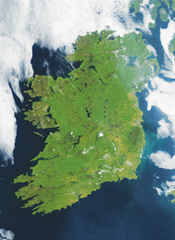An island economy
 Border counties have been neglected and improvements in rail infrastructure would simplify business between North and South, according to a new analysis.
Border counties have been neglected and improvements in rail infrastructure would simplify business between North and South, according to a new analysis.
Following the Good Friday Agreement there was “a degree of optimism that peace would bring prosperity that was similar to that of the newly liberalised states of central and eastern Europe when they were released from the constraining shackles of Communism in 1989,” according to economists John Bradley and Michael Best.
The pair are currently researching ‘the post-Belfast Agreement border region economy’, and updated the sixth annual Journal of Cross Border Studies on their work.
Despite the fact that in 1998 ‘Northern Ireland plc’ was declared “open for business”, Bradley and Best claim that the decade following the Agreement was characterised by “excessive optimism” on the part of Northern policy makers and “benign passivity” from Southern policy makers.
At the moment, Northern Ireland is “utterly dependent on continued support from the UK exchequer since its export-generating private sector is simply too small to pull it out of recession as the global economy improves.”
Bradley and Best were “shocked” that Northern Ireland does not provide statistics relating to regional economic data like the Central Statistics Office in the Republic does. From the CSO data, the pair could conclude that the Southern border counties dealt mainly in agriculture, building and construction, manufacturing, market services and the public sector.
However, “no effective effort” was made to gather similar data in Northern Ireland.
Therefore it is “very difficult, if not impossible, for policy makers to understand what the sub-regional challenges are.”
In addition, the planning and renewal of the border region was delegated to local authorities, “many of whom were ill equipped to undertake the task because of their small size and their limited human and other resources.” Consequently, Bradley and Best believe, “there was never going to be any fully integrated planning of island infrastructure.”
In the coming years, Northern Ireland will be restricted as the UK Treasury decided to cut back public expenditure and the Republic “has been forced to surrender key elements of its already modest economic sovereignty to the IMF and the ECB.” Therefore, growth initiatives must come from “within rather than without,” the authors claim.
Major infrastructural improvements have eased the Belfast-Dublin connection on the east coast corridor, “but there has not been much change in the border region.” Because Northern Ireland’s manufactured goods are mainly traded with Britain, the incentive to locate plants in or near the border region (outside the eastern corridor) “is much diminished.”
Despite this, the pair found that the border itself was not a barrier once a company had identified a target market. They were told by one Monaghan businessman that “green had always traded with orange.” They use an example of Crossgar Food Services, where delivery vans leave the factory outside Downpatrick late at night and can make deliveries to Cork by 5am.
While the journey time between Belfast and Dublin has been reduced to two hours because of the Newry bypass and investment in the M1 motorway, ESRI transport researcher Edgar Morgenroth argues that the Enterprise train service needs to be improved because it no longer has a “speed advantage” (it takes 127 minutes).
Morgenroth quotes Mandel et al (1994) who found that a one per cent reduction in travel time would increase rail demand by one per cent while a one per cernt reduction time in car travel would only increase demand by 0.14 per cent. His own study of 35 European city pairs found that services that run over a longer distance and more frequently are quicker. An average speed improvement of 24 km/h on the Belfast-Dublin line would reduce travel time to 100 minutes and an extra 12 trains would be needed in each direction in order to reach European bench-marking standards.
He concludes that a quicker and more regular Belfast-Dublin train service would bring economic advantages. However, a separate track for such as service (which would be the most desirable option because trains currently approaching Connolly station have to slot in behind local DART services and wait) is unlikely due to financial restrictions in the Republic.





